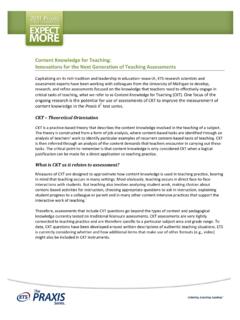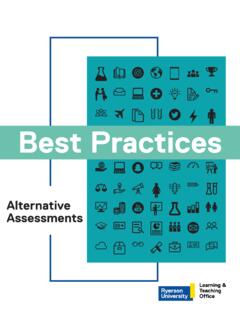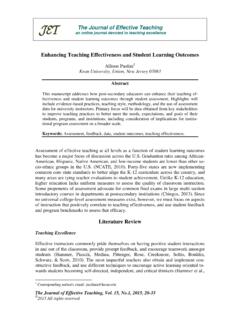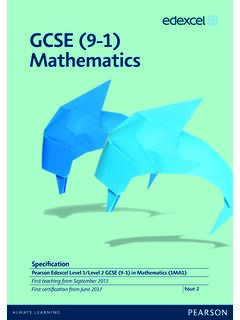Transcription of Computer Use by School Teachers in Teaching-learning Process
1 Journal of Education and Training Studies Vol. 1, No. 2; October 2013 ISSN 2324-805X E-ISSN 2324-8068 Published by Redfame Publishing URL: 174 Computer Use by School Teachers in Teaching-learning Process Jyoti Bhalla Department of Educational Studies, Faculty of Education, Jamia Millia Islamia, New Delhi 110025, India Correspondence: Jyoti Bhalla, 322, Pragati Appartments, Punjabi Bagh Club Road, Paschim Vihar, New Delhi 110063, India. Tel: 91-931-144-3210. E-mail: Received: March 3, 2013 Accepted: April 2, 2013 Online Published: June 26, 2013 URL: Abstract developing countries have a responsibility not merely to provide computers for schools, but also to foster a habit of infusing a variety of ways in which computers can be integrated in Teaching-learning amongst the end users of these tools.
2 Earlier researches lacked a systematic study of the manner and the extent of Computer -use by Teachers . The current study examined a comprehensive investigation of 300 Central School Teachers use of computers in India. Towards this end, a questionnaire was constructed that listed essential dimensions for Teachers use of computers: Computer Aided Learning (CAL), Computer Managed Instruction (CMI), and Computer Assisted Instruction (CAI). The findings revealed that Teachers often used computers to update subject knowledge and teaching skills, develop lesson plans, prepare additional instructional material, notify relevant information via internet, prepare question banks.
3 They sometimes used computers for showing something in the class, showcasing students work on School -website, preparing test papers, simulations, games, students assignments. They had either rarely or never used computers for presenting entire lesson, students classroom presentations, tutorials, sharing information with parents, publishing homework, giving tests to students either offline or online, maintaining students records, and individualized instructions. The analysis indicated that amongst the three categories of Computer use, CAL was the most popular category of Computer use whereas CAI was the least popular among Teachers .
4 The results help to demystify seeming inconsistency and variation with regard to Computer use among Teachers . The identification of comprehensive ways of Computer use empowers stakeholders with vital information and may assist implementation of appropriate measures to fully infuse computers in Teaching-learning Process . Keywords: Computer -use, Computer aided learning (CAL), Computer managed instruction (CMI), and Computer assisted instruction (CAI) 1. Introduction The past two decades have witnessed a dynamic shift in the way the computers have been used as a tool in the Teaching-learning Process .
5 Today, the trend appears to be towards the creation of courses specifically aimed at Computer literacy, as well as towards integrating Computer technology in other content areas across the curriculum. Further, Computer technology has increasingly been applied towards non-instructional (record keeping, grade averaging, communication, etc.) and pre-instructional ( developing materials, researching instructional content, etc.) uses. This great change has brought forth a fresh perspective in the use of computers in the Teaching-learning Process .
6 The recent advancement in information technology innovations and Computer usage is rapidly transforming work culture and Teachers cannot escape the fact that today s teaching must provide technology-supported learning. Moreover, links have been made between Computer use and constructivist, collaborative, and inquiry-based learning and also pedagogical change (Scrimshaw, 2004). Some researchers suggest that Computer technology can overhaul education, serving as a panacea, or as an agent of change.
7 Generally, it is accepted that computers have the potential to enhance teaching and learning (Gordin, Hoadley, Means, Pea, Roschelle, 2000) and provide students with a learning experience that other strategies cannot provide (Wellington, 2005). Therefore, being prepared to adopt and use technology and knowing how that can support student learning must become integral skills in every teacher s professional repertoire. Governments in most developing countries have responded to the challenge by initiating national programs to introduce computers in education.
8 To better prepare pre-service candidates for teaching in the information age, the International Society for Technology in Education (ISTE) has defined National Educational Technology Journal of Education and Training Studies Vol. 1, No. 2; 2013 175 Standards (NETS) (2002) to guide technology integration into teacher education programs. These include dividing the Teachers application of technology in instruction into six categories: technology related - understanding, designing of experiences, implementation of curriculum plans, assessment strategies, enhancement of productivity, legal-ethical issues.
9 The United Nations Educational, Scientific and Cultural Organization (UNESCO) implemented Beijing workshop (2003) on Teacher Training in ICT Integration discussed guidelines for developing Competency Based Standards for Teacher Education Curriculum which comprised of core competencies related to pedagogy (new ways of doing things with Information and Communications Technology (ICT), new theories of learning, pedagogical skills: selection, presentation and assessment); technology (related concepts and operations, social, health, legal and ethical issues); and technology-pedagogy integration (ethical and legal use of technology to design effective learning experiences, manage students learning, improve professional skills, support interaction in learning/social communities).
10 One developing country that is currently pursuing the technological track in education is India. Recognizing the challenge of the information age , the Indian National Curriculum Framework for School Education, NCERT (National Council of Educational Research and Training) through Curriculum Guide Syllabus for Information Technology in Schools, 2001 addresses at length the question of integration of ICT into schooling, acknowledges the pedagogical rationale behind this integration and brings to the fore its manifold implications.
















